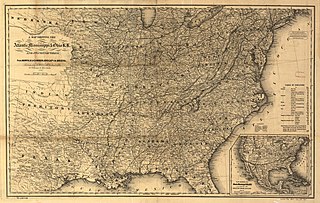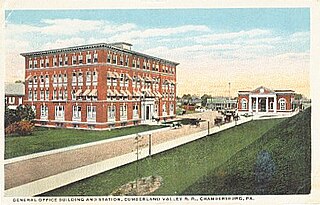
The Northeast Regional is an intercity rail service operated by Amtrak in the Northeastern and Mid-Atlantic United States. In the past it has been known as the NortheastDirect, Acela Regional, or Regional. It is Amtrak's busiest route, carrying 9,163,082 passengers in fiscal year (FY) 2023. The Northeast Regional service earned over $787.7 million in gross ticket revenue in FY 2023.

The Norfolk and Western Railway, commonly called the N&W, was a US class I railroad, formed by more than 200 railroad mergers between 1838 and 1982. It was headquartered in Roanoke, Virginia, for most of its existence. Its motto was "Precision Transportation"; it had a variety of nicknames, including "King Coal" and "British Railway of America". In 1986, N&W merged with Southern Railway to form today's Norfolk Southern Railway.

Alexandria Union Station is a historic railroad station in Alexandria, Virginia, south of Washington, D.C. To avoid confusion with nearby Washington Union Station, the station is often referred to as simply Alexandria. Its Amtrak code is ALX.

Atlantic, Mississippi and Ohio Railroad (AM&O) was formed in 1870 in Virginia from three east–west railroads which traversed across the southern portion of the state. Organized and led by former Confederate general William Mahone (1826-1895), the 428-mile (689 km) line linked Norfolk with Bristol, Virginia by way of Suffolk, Petersburg, Lynchburg, and Salem. The AM&O was promoted as a trade link to the west, and further expansion was envisioned with the goal of increasing Virginia's Ohio Valley and Mississippi Valley commerce. It was heavily backed by investors from England and Scotland.

The Charlottesville Union Station, located in Charlottesville, Virginia, United States, is served by Amtrak's Cardinal,Crescent, and daily Northeast Regional passenger trains. It is Amtrak's third-busiest station in Virginia, aside from its all-auto Auto Train station in Lorton. The station is situated in the northeast quadrant of the junction between two railway lines. The Cardinal uses the east–west line, owned by the state of Virginia, and formerly by CSX Transportation, and operated by the Buckingham Branch Railroad, while other services use the north–south line owned and operated by Norfolk Southern Railway. The station is within walking distance of the University of Virginia, which is the major employer in the area.

Transportation in the Commonwealth of Virginia is by land, sea and air. Virginia's extensive network of highways and railroads were developed and built over a period almost 400 years, beginning almost immediately after the founding of Jamestown in 1607, and often incorporating old established trails of the Native Americans.
Shenandoah Valley Railroad was a line completed on June 19, 1882, extending up the Shenandoah Valley from Hagerstown, Maryland through the West Virginia panhandle into Virginia to reach Roanoke, Virginia and to connect with the Norfolk and Western Railway (N&W). The development of this railroad had considerable backing from the Pennsylvania Railroad. In September 1890 it went into bankruptcy and was reorganized as the Shenandoah Valley Railway. In December 1890, it became part of N&W. Today the tracks are a major artery of the Norfolk Southern system.

Kemper Street station, also known as Lynchburg station, is an intermodal transit station in Lynchburg, Virginia, United States. It serves Amtrak while an adjacent bus transfer center serves Greater Lynchburg Transit Company and Greyhound buses. Kemper Street Station is located at 825 Kemper Street.

Newport News station is an Amtrak inter-city train station in Newport News, Virginia. The station is the southern terminus of two daily Northeast Regional round trips. It has a single side platform adjacent to a large CSX rail yard. An Amtrak Thruway motorcoach connection to Norfolk station effectively doubles the frequency between each station and Washington.

The Cumberland Valley Railroad was an early railroad in Pennsylvania, United States, originally chartered in 1831 to connect with Pennsylvania's Main Line of Public Works. Freight and passenger service in the Cumberland Valley in south central Pennsylvania from near Harrisburg to Chambersburg began in 1837, with service later extended to Hagerstown, Maryland, and then extending into the Shenandoah Valley to Winchester, Virginia. It employed up to 1,800 workers.

The Hilltopper was a passenger train operated by Amtrak in the Mid-Atlantic region of the United States. It ran daily from South Station in Boston, Massachusetts to Catlettsburg station in Catlettsburg, Kentucky. The 1,674 mi (2,694 km) run made 34 stops in 11 states and the District of Columbia.

Norfolk Terminal Station was a railroad union station located in Norfolk, Virginia, which served passenger trains and provided offices for the Norfolk and Western Railway, the original Norfolk Southern Railway and the Virginian Railway. The N&W, Norfolk Southern, and Virginian's Norfolk terminal location stood in contrast to competitor railroads, such as the Chesapeake & Ohio Railroad, Southern Railway, Atlantic Coast Line Railroad, Pennsylvania Railroad and Seaboard Air Line Railroad which operated out of Cape Charles (Virginia), Newport News and Portsmouth, terminals outside of Norfolk. Customers took ferries or, later in the 20th century, buses from Norfolk to reach those other terminals. The terminal was located at 1200 East Main Street in Norfolk, near today's Harbor Park baseball stadium.

Norfolk and Western 611, also known as the "Spirit of Roanoke" and the "Queen of Steam", is the only surviving example of Norfolk and Western's (N&W) class J 4-8-4 type "Northern" streamlined steam locomotives. Built in May 1950 at N&W's Roanoke Shops in Roanoke, Virginia, it was one of the last mainline passenger steam locomotives built in the United States and represents one of the pinnacles of American steam locomotive technology.

The Birmingham Special was a passenger train operated by the Southern Railway, Norfolk and Western Railway, and Pennsylvania Railroad in the southeastern United States. The train began service in 1909 and continued, with alterations, after Amtrak assumed control of most long-haul intercity passenger rail in the United States on May 1, 1971. The Birmingham Special is the namesake of the famed Glenn Miller big band tune "Chattanooga Choo Choo".

The Mountaineer was a passenger train operated by Amtrak between Norfolk, Virginia, and Chicago, Illinois, via Cincinnati, Ohio. It was the first train to use the Norfolk and Western Railway's tracks since the creation of Amtrak in 1971 and followed the route of the Pocahontas, the N&W's last passenger train. Service began in 1975 and ended in 1977. A new train, the Hilltopper, operated over much of the Mountaineer's route but was itself discontinued in 1979.

Bristol station is a historic railroad station in Bristol, Virginia, USA, just north of the Tennessee state line. Built in 1902, the station was served by passenger trains until 1971. It was listed on the National Register of Historic Places as Bristol Railroad Station in 1980.

Amtrak Virginia is the collective name for Virginia's state-supported Amtrak train service, all of which falls under the Northeast Regional brand. Amtrak Virginia trains run between Washington, D.C., and one of four southern termini: Richmond, Newport News, Norfolk, or Roanoke. Trains generally continue north from D.C. along the Northeast Corridor, providing one-seat rides from Virginia to Baltimore, Philadelphia, New York City, and Boston.

Farmville station was an intercity rail station located in Farmville, Virginia. It was served by Norfolk and Western Railway passenger trains until around 1971. It was later served by Amtrak's Mountaineer from 1975 to 1977, then the Hilltopper until 1979. The station building remains extant.

Bedford station was an intercity rail station located in Bedford, Virginia. It was served by Norfolk and Western Railway passenger trains until 1971. It was later served by Amtrak's Mountaineer from 1975 to 1977, then the Hilltopper until 1979. The station building remains extant and is used as a restaurant.

Christiansburg station was an intercity rail station located in Christiansburg, Virginia. Originally built in 1906 to replace a previous station, it was served by Norfolk and Western Railway passenger trains until 1971. It was later served by Amtrak's Mountaineer from 1975 to 1977, then the Hilltopper until 1979. The station building remains extant.






















